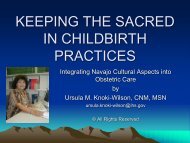Ethical Space for a Sensitive Research Topic - National Aboriginal ...
Ethical Space for a Sensitive Research Topic - National Aboriginal ...
Ethical Space for a Sensitive Research Topic - National Aboriginal ...
Create successful ePaper yourself
Turn your PDF publications into a flip-book with our unique Google optimized e-Paper software.
Lake Superior. The populations of the communities range from<br />
70 to 832 individuals.<br />
Meeting participants included chiefs, band council<br />
members, and community employees. All demonstrated a<br />
strong interest in learning more about the proposed HPV<br />
research. The scientific portion of the research dialogue<br />
was short, as the main purpose of the session was to create<br />
ethical space <strong>for</strong> knowledge exchange about cervical cancer<br />
prevention research between community leaders and the<br />
research team. Community representatives engaged in an<br />
active dialogue following our presentation and stated their<br />
desire to uncover the reasons <strong>for</strong> the high rates of cervical<br />
cancer among First Nations women. The need <strong>for</strong> health<br />
education and disease prevention activities related to HPV was<br />
seen as a priority in many communities. Meeting participants<br />
provided in<strong>for</strong>mation on the desired engagement and research<br />
process, which was incorporated into the research approach.<br />
Specifically, at this level of dialogue, the research team<br />
members were encouraged to: (a) attend community events<br />
in order to build a better relationship with the women of the<br />
communities, (b) present at annual health fair and cultural<br />
celebrations to raise awareness about the study and cervical<br />
cancer prevention in general, (c) develop a clearly outlined<br />
<strong>Ethical</strong> <strong>Space</strong> <strong>for</strong> a <strong>Sensitive</strong> <strong>Research</strong> <strong>Topic</strong><br />
FIGURE 2. WIDENING THE ETHICAL SPACE OF FIRST NATIONS COMMUNITY ENGAGEMENT FOR<br />
CERVICAL CANCER PREVENTION RESEARCH<br />
process <strong>for</strong> HPV testing that was to remain blinded at the<br />
community level to give optimum privacy to participants, and<br />
(d) draft research agreements that could be tailored to the<br />
needs of the respective communities.<br />
As a follow-up, the researchers sent thank-you letters to<br />
all participating chiefs and councils with a summary of the<br />
pilot study (Zehbe et al., in press) attached. Communities that<br />
had not sent representatives to this meeting were contacted<br />
shortly thereafter with an in<strong>for</strong>mation package and followup<br />
phone calls. Next, a draft research agreement was sent to<br />
each chief and council via email as requested, <strong>for</strong> review and<br />
feedback.<br />
Development of research agreements<br />
When working with First Nations communities, it is necessary<br />
to obtain support and approval from the chief and band<br />
council be<strong>for</strong>e commencing any work with individuals of<br />
the community (Interagency Advisory Panel on <strong>Research</strong><br />
Ethics, 2010). This encourages the development of a respectful<br />
relationship and in this case led to the development of <strong>for</strong>mal<br />
research agreements, detailing roles, responsibilities, benefits,<br />
risks, and expectations to be shared by the participating<br />
Journal of <strong>Aboriginal</strong> Health, March 2012 45






